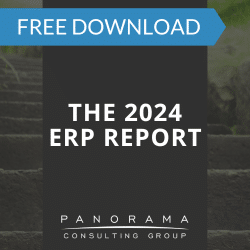An ERP system can help you automate your most time-consuming tasks. It gives you a central, comprehensive platform where you can store and collect data. Any ERP expert will tell you that these systems deliver valuable insights you can use to drive smarter decision-making.
However, what happens when you go live and find that you lack the depth and quality of data you expected?
Today, we’re talking about a subject that’s not so fun to talk about, but it’s important to cover: What happens when your ERP implementation hurts your data analytics capability rather than helps it? Let’s take a look at what you can do.
What to do When Your ERP Implementation Diminishes Your Data Insights?
1. Take a Look at Your Processes
One reason for ERP failure is that companies don’t think twice before automating all their existing workflows.
According to Bill Baumann, Panorama Consulting Group’s Director of Software Expert Witness, “If it’s not working for you before you start the ERP implementation process, it won’t work afterward. The goal isn’t to keep everything the same and simply add automation on top of it. Rather, you’re looking for ways to improve current operations by strategically automating certain functions.”
This is why you can’t afford to skip the business process management or business process reengineering step of your project. This is the time when you map your workflows, identify pain points, and think about the features that you need to solve them. This way, you’ll know exactly what to look for when it’s time to choose a vendor.
If you’ve gone live with your ERP system and it’s not delivering the results you want, it might be time to go back to the drawing board. Together with your project team, understand where issues are occurring that are keeping you from securing the data you need for your decisions. Once you find those inefficiencies, decide if you need to add new features or adjust others.
A Failed Payroll System Implementation
Panorama’s Expert Witness team was retained to provide a forensic analysis and written report to the court regarding the failed implementation of a major software developer’s ERP/payroll system.
2. Consider Employee Perspectives
A major part of planning an ERP implementation is setting key performance indicators (KPIs). In short, these measure how you’ll define success once the system is live. Some of the most common KPIs include:
• Revenue and sales growth
• Project margin
• Customer experience
• Business productivity
• Employee satisfaction
Let’s talk about that last bullet point a little more. Do you have any way to measure how satisfied your employees are with the new system? If they’re not loving the new features, there’s a good chance they’re not using them.
When this happens, your system becomes inefficient. Without regular data inputs, the system will rely on outdated information.
If you don’t already have a strategy to gauge how well your workforce is adapting to the software, we recommend having one-on-one conversations, hosting focus groups, conducting surveys, and taking polls to better understand employees’ sentiments. It’s never too late to focus on organizational change management, and prioritizing employee input could make a major difference in how useful your ERP system becomes.
Insights from a software expert witness: “As a software expert witness, I have seen many digital transformation projects succeed or fail based on how well the change was managed. My experience has taught me that involving employees in the process from the beginning is critical.”
3. Check Your Data for Accuracy
If you’re unable to glean data-driven insights from your ERP software, the data itself could be to blame. Did you migrate old, outdated, or incomplete fields over from your legacy systems into the new system?
Data cleansing and migration are important steps. Skipping or rushing through this process could render your entire system less effective than it should be.
It may take a while, but it’s important to check the data in your ERP system to make sure it’s correct. Even if the new fields you’re entering are accurate, putting those records on top of old, inaccurate ones can impact data reliability.
4. Ensure Proper Software Integration
Managing ERP data starts with making sure all your systems are properly connected and communicating. For ERP software to work, it must be able to interface with the other core systems you use throughout your organization.
Modern, cloud-based ERP systems do this more easily, but it’s still possible to miss a connection.
Complete software integration is the key to assembling all your data into the ERP platform, where it can be organized into actionable insights. If your customer relationship management or supply chain management systems aren’t “talking to” your ERP system, you could miss important information.
Without this step, your teams are forced to work in siloes. Important updates get missed, employees are working over one another, and teamwork is next to impossible.
Get More From Your ERP Implementation
An ERP implementation is designed to make your life easier, not harder. Yet, this is exactly what could happen when your software doesn’t deliver the data insights you expected.
If your system doesn’t enable you to make data-driven decisions, your project isn’t necessarily a failure. There are steps you can take to correct this issue and achieve the ERP benefits you deserve.
Reach out to our independent ERP consultants if you need more support. We are happy to provide a free consultation.













